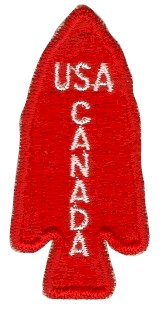Project Plough
| 1st Special Service Force | |
|---|---|

1st Special Service Force shoulder patch
|
|
| Active | 1942–44 |
| Country |
|
| Allegiance | Allied Forces |
| Branch | Army |
| Type | Commando |
| Role | Special operations |
| Size | 1,400 |
| Garrison/HQ | Fort William Henry Harrison |
| Nickname(s) | The Devil's Brigade, The Black Devils |
| Equipment | See: 'Unique weapons' |
| Engagements | See: 'Combat service' |
| Disbanded | 5 December 1944 |
| Commanders | |
| Notable commanders |
Robert T. Frederick |
The 1st Special Service Force (also called The Devil's Brigade, The Black Devils, The Black Devils' Brigade, and Freddie's Freighters), was an elite American-Canadian commando unit in World War II, under command of the United States Fifth Army. The unit was organized in 1942 and trained at Fort William Henry Harrison near Helena, Montana in the United States. It fought in the Aleutian Islands, Italy, and southern France before being disbanded in December 1944.
The modern American and Canadian special operations forces trace their heritage to this unit. In 2013, the United States Congress passed a bill to award the 1st Special Service Force the Congressional Gold Medal.
Geoffrey Pyke was an English journalist, educationalist, and later an inventor whose clever, but , ideas could be difficult to implement. In lifestyle and appearance, he fitted the common stereotype of a scientist-engineer-inventor or in British slang, a "boffin". This was part of the British approach in World War II of encouraging innovative warfare methods and weapons that was personally backed by Churchill. Hobart's Funnies are another example. Pyke, working for the British Combined Operations Command, envisioned the creation of a small, élite military force capable of fighting behind enemy lines in winter conditions. This would have been a commando unit that could be landed, by sea or air, into occupied Norway, Romania, and the Italian Alps on sabotage missions against hydroelectric plants and oil fields. In Norway, the chief industrial threat was the creation of the heavy water used in the German atomic weapon research at Rjukan. Furthermore, attacks on Norwegian power stations, which supplied the country with 49% of its power, might drive the Axis powers out of the country and give the Allies a direct link to Russia. In Romania, there were the strategically important Ploiești oil fields that met one quarter of the Germans' consumption, and Italian hydroelectric plants powered most of south German industry. Pyke requested that a tracked vehicle be developed especially for the unit, capable of carrying men and their equipment at high speed across snow-covered terrain.
...
Wikipedia
